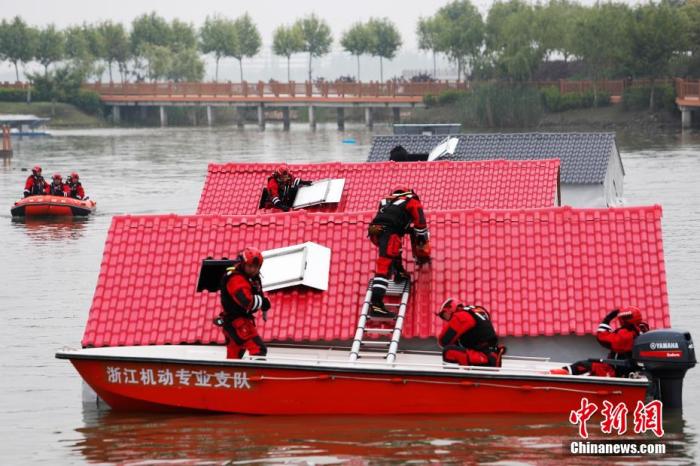China News Service, May 7th. In response to this year's flood control situation and prevention and response methods, Zhou Xuewen, a member of the Party Committee and Vice Minister of the Emergency Management Department, responded to this at a press conference held by the State Information Office today.
At the meeting, a reporter asked: We know that heavy floods occurred in many parts of southern my country during the flood season last year, and some parts of southern my country have also entered floods.
What is the flood prevention situation this year, and how will the Emergency Management Department prevent and respond?
Zhou Xuewen responded that according to the forecast of the Meteorological Department, our country’s climate conditions during the flood season this year are generally average to deviation, with both droughts and floods, regional and phased droughts and floods are obvious, extreme weather events are more frequent, and the main rainy areas in summer are in our country. In the north, the upper and middle reaches of the Yellow River, parts of the Haihe River basin, the Songhua River basin, and the eastern part of the Pearl River basin in the south may have heavy floods; most of Xinjiang and the middle reaches of the Yangtze River may have less precipitation, prone to periodic drought; The number of landing typhoons may be too high.
Data map: On April 28, the police aviation team of the Shanghai Public Security Bureau was conducting emergency rescue in the waters of Dianshan Lake.
Photo by Yin Liqin
Zhou Xuewen said that in response to such climate predictions, we will do our best to prevent major floods, fight major droughts, fight major dangers, and rescue major disasters.
The National Defense Office and the Ministry of Emergency Response will strengthen the work of six key links.
The first link is to strengthen the implementation of responsibilities for flood control and drought relief.
The main purpose is to strengthen the implementation of flood control and drought relief responsibilities with the administrative chief responsibility system as the core, and to consolidate various flood control responsibilities of key flood control projects.
In response to this year’s city, county, and township-level government re-election, we will increase the training of responsible persons at all levels, especially newly appointed ones, clarify their responsibilities and tasks, let them familiarize themselves with the plan, understand weak links, and improve the level of flood control decision-making and command. Ability to prevent, control and dispose of risks.
The second link is to strengthen the investigation and rectification of hidden dangers.
Many provinces in my country suffered severe floods last year, and the task of repairing water damage projects and facilities is relatively heavy. It is necessary to urge all localities to comprehensively investigate the risks and hidden dangers of flood safety, establish a work account, and clarify the time limit for rectification.
If it is difficult to complete the rectification before the flood, it is necessary to implement specific measures for the safety of the flood.
The third link is to strengthen the revision of the plan.
In view of the prominent problems and weak links in flood prevention and drought relief, various plans and plans must be further revised and improved, and coordination between departments must be optimized to effectively form a work force.
According to climate forecasts, some rivers in the north may have severe flooding this year, and some rivers have not experienced major floods for many years. The relevant plan plans lack actual combat tests. It is necessary to strengthen response drills, improve the emergency linkage mechanism, and improve the pertinence and availability of these plan plans. Operational.
The fourth link is to strengthen the mass transfer to avoid danger.
Organizing the masses to transfer and avoid danger in time before the flood is a key measure to effectively reduce casualties.
In particular, the proportion of casualties caused by flash flood disasters is high every year, and the vast majority of casualties in flood disasters are caused by flash flood disasters.
On the basis of research and investigation, the National Defense Office specially formulated and issued the "Guiding Opinions on Strengthening the Transfer of Persons from the Hilly Area during the Heavy Rain Period". The five key links of "time transfer", "who organizes", "how to transfer" and "transferred personnel management" put forward some specific requirements, and we must urge all localities to further implement them.
The fifth link is to strengthen disaster prevention and response.
Together with water conservancy, natural resources, meteorological and other departments, we must closely monitor the development and changes of floods, droughts, customs, dangers and disasters, strengthen the joint discussion and judgment, release forecast and early warning information in a timely manner, scientifically dispatch flood control projects, strengthen dam inspections and defenses, and preset emergency rescues. Teams and materials to ensure early detection and early disposal of dangerous situations.
The sixth link is to strengthen emergency rescue and disaster relief.
The Emergency Management Department has strengthened the docking of various rescue teams at the ministerial and local levels, and specifically deployed local finger defenses to improve the rescue and rescue docking mechanism.
According to the development of flood conditions, emergency rescue forces such as national comprehensive fire rescue teams will be deployed in front to ensure rapid response, timely arrival and efficient rescue in emergencies and disasters, fully protect the lives and property safety of the people, and do a good job in disaster relief. , To protect the basic livelihood of the victims.

